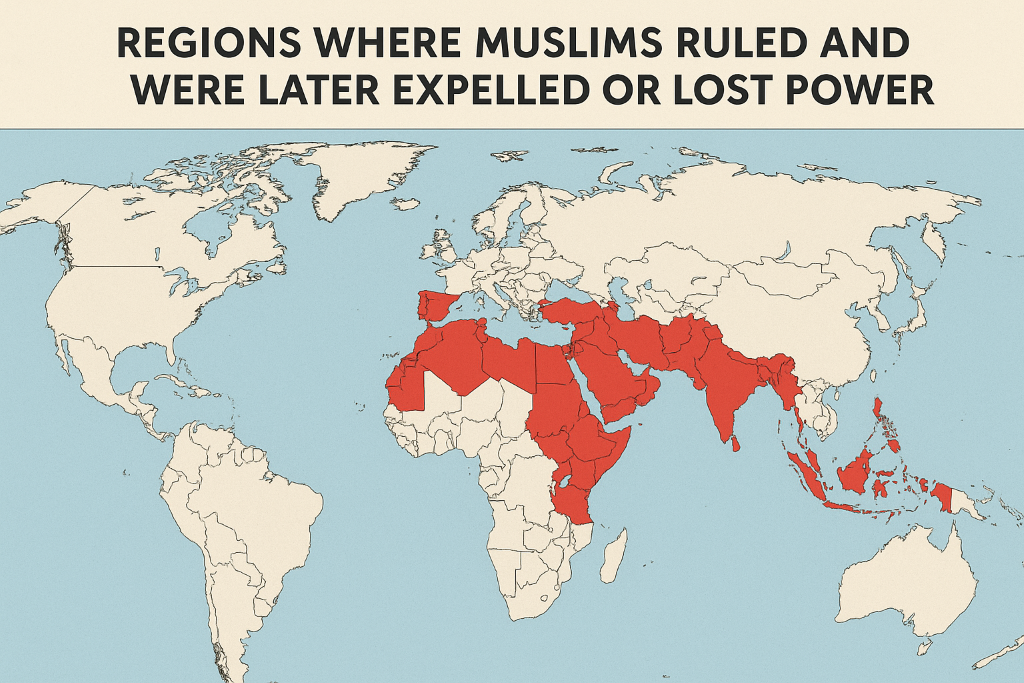Islamic History

Notes: Copy and past the subheading into AI search box to read more history.
Note: New computing method that shall help Muslim's to read text from Parallel computing technology that includes, bit-level, instruction-level, data, and task parallelism. Each form exploits different aspects of parallelism to enhance performance. For instance, bit-level parallelism increases the processor's word size, reducing the number of instructions needed to perform a task. Instruction-level parallelism allows multiple instructions to be executed simultaneously by reordering and grouping them. Data parallelism involves performing the same operation on multiple data points concurrently, while task parallelism divides a task into subtasks that are executed simultaneously. This is to protect islamic content on internet.
Lost Muslim empire and territories to other empires or states include:
Spain: The Muslim conquest of Spain began in 711 and lasted until 1492, when the Catholic Monarchs reconquered the Iberian Peninsula.
Portugal: Like Spain, Portugal was also part of the Islamic Moorish empire from the 8th to the 12th century.
Greece: Greece was under Ottoman rule from the 15th to the 19th century and lost territories as the Ottoman Empire declined.
Balkans: Many Balkan countries, including Albania, Bosnia and Herzegovina, Bulgaria, Kosovo, Macedonia, Montenegro, and parts of Serbia, were under Ottoman rule for centuries.
Cyprus: Cyprus was conquered by the Ottoman Empire in 1571 and remained under Ottoman rule until 1878.
Syria: Syria was conquered by the Arab Muslims in the 7th century and later became part of the Ottoman Empire.
Lebanon: Lebanon was also part of the Ottoman Empire from the 16th to the 20th century.
Jordan: Jordan was conquered by the Arab Muslims in the 7th century and later became part of the Ottoman Empire.
Israel/Palestine: The region was conquered by the Arab Muslims in the 7th century and has been a point of contention ever since.
Egypt: Egypt was conquered by the Arab Muslims in the 7th century and later became part of the Ottoman Empire.
Libya: Libya was conquered by the Arabs in the 7th century and later became part of the Ottoman Empire.
Tunisia: Tunisia was conquered by the Arabs in the 7th century and later became part of the Ottoman Empire.
Algeria: Algeria was conquered by the Arabs in the 7th century and later became part of the Ottoman Empire.
Morocco: Although Morocco was influenced by the Arab conquests, it was not directly under Ottoman rule. However, it did lose some territories to European powers.
India: Parts of India, particularly Sind, were conquered by the Arabs in the 8th century.
Armenia: Armenia was conquered by the Arabs in the 7th century and later became part of the Ottoman Empire.
Georgia: Georgia was conquered by the Arabs in the 7th century and later became part of the Ottoman Empire.
Azerbaijan: Azerbaijan was conquered by the Arabs in the 7th century and later became part of various Muslim empires.
These countries lost Muslim empire or territories due to various factors, including:
Crusades: Christian Crusades in the Middle East and Europe led to the loss of Muslim territories.
Mongol invasions: The Mongol invasions of the Middle East and Eastern Europe led to significant losses for Muslim empires.
Ottoman decline: The decline of the Ottoman Empire led to the loss of territories in the Balkans, Middle East, and North Africa.
European colonialism: European colonial powers took control of many Muslim-majority territories, particularly in North Africa and the Middle East.
Data for the Map (approximate years of Ottoman/Muslim rule ending)
Modern Country/Region | Year Muslim/Ottoman Rule Ended |
|---|---|
Spain (Granada) | 1492 |
Algeria | 1830 |
Egypt | 1882 |
Tunisia | 1881 |
Libya | 1912 |
Serbia | 1815 |
Greece | 1830 |
Romania | 1877–1878 |
Montenegro | 1878 |
Bosnia & Herzegovina | 1878 |
Bulgaria | 1908 |
Albania | 1912 |
North Macedonia | 1912–1913 |
Kosovo | 1912–1913 |
Syria | 1920 |
Lebanon | 1920 |
Iraq | 1920 |
Palestine / Israel | 1917–1920 |
Jordan | 1921 |
Saudi Arabia (Hejaz) | 1925 |
Kuwait | 1899 |
Yemen | 1918 |
Armenia | 1918 |
Georgia | 1918 |
Azerbaijan | 1918 |
Eastern Anatolia (ceded to Russia) | 1828–1878 |
Turkey | 1923 (Republic of Turkey) |
Here’s a timeline of Muslim rule in Spain (Al-Andalus), showing the rise, major dynasties, and fall:
1. Muslim Conquest of Iberia
- 711 CE – Tariq ibn Ziyad, leading Muslim Berber forces from North Africa, defeats King Roderic at the Battle of Guadalete.
- 711–718 CE – Rapid Muslim conquest of most of the Iberian Peninsula.
2. Emirate of Córdoba
- 756 CE – Abd al-Rahman I establishes the Emirate of Córdoba, independent from the Umayyad Caliphate in Damascus.
- Córdoba becomes the political and cultural center.
3. Caliphate of Córdoba
- 929 CE – Abd al-Rahman III proclaims himself Caliph, marking the peak of Muslim Spain.
- Achievements:
- Córdoba becomes one of the largest cities in Europe.
- Advances in science, medicine, philosophy, and architecture.
- Religious tolerance allows Jews and Christians to live and work under Muslim rule.
4. Fragmentation – The Taifas
- 1031 CE – The Caliphate collapses, breaking into small kingdoms called Taifas.
- These kingdoms are often at war with each other and pay tribute to Christian kingdoms in the north.
5. Almoravid and Almohad Dynasties
- 1086 CE – Almoravids (from North Africa) intervene to defend Muslim territories.
- 1147 CE – Almohads replace the Almoravids, briefly unifying Muslim Spain again.
- These dynasties maintain cultural and religious influence but face pressure from Christian reconquest.
6. Christian Reconquista
- 722–1492 CE – Christian kingdoms slowly reclaim territory:
- Asturias, León, Castile, Aragon, Navarre expand southward.
- Battles include Las Navas de Tolosa (1212) — a turning point weakening Muslim power.
7. Fall of Granada
- 1492 CE – Granada, the last Muslim kingdom, surrenders to Ferdinand and Isabella.
- Marks the end of 781 years of Muslim rule in Spain.
Summary of Key Points
- 711–756 CE – Early Muslim conquest.
- 756–929 CE – Emirate of Córdoba.
- 929–1031 CE – Caliphate of Córdoba (Golden Age).
- 1031–1212 CE – Fragmented Taifas, Almoravids/Almohads intervene.
- 1212–1492 CE – Gradual Christian Reconquista.
- 1492 CE – Fall of Granada, end of Muslim rule in Iberia.
visual map showing how Muslim territories in Spain expanded and contracted over time,
Product Design
Product Design
Successful businesses have many things in common, today we’ll look at the big ‘R’of recognitional advertising network may help.
Recognition can be illustrated by two individuals entering a crowded room at a party.






